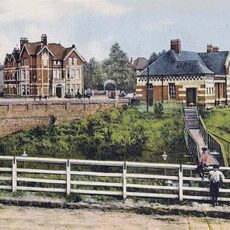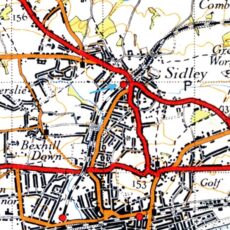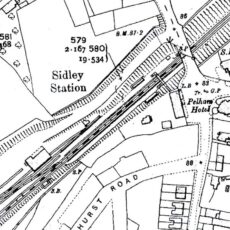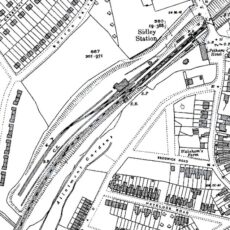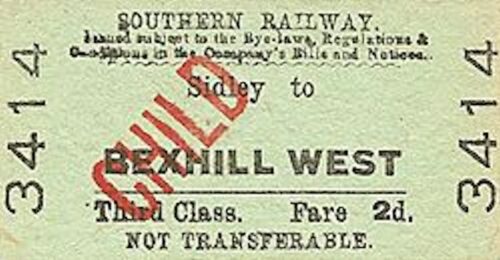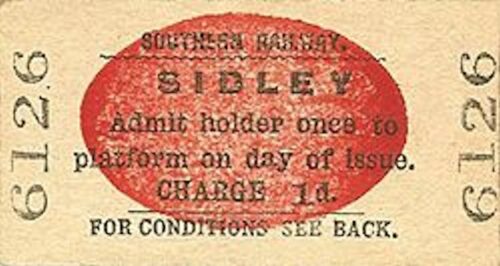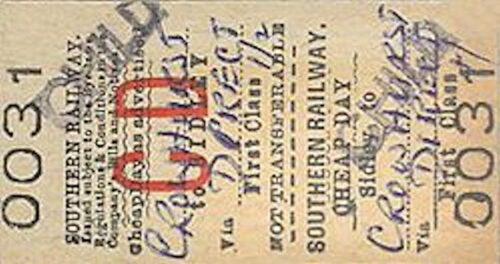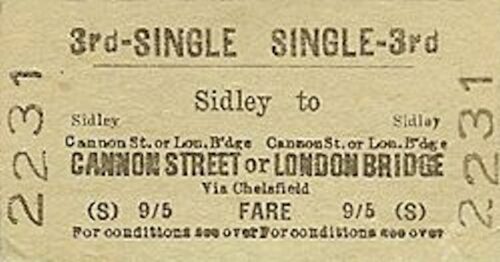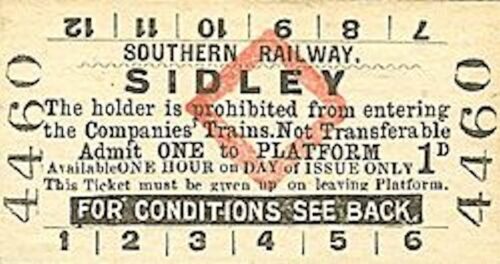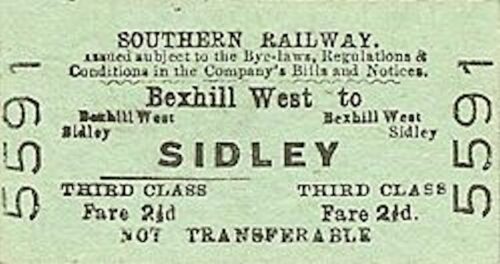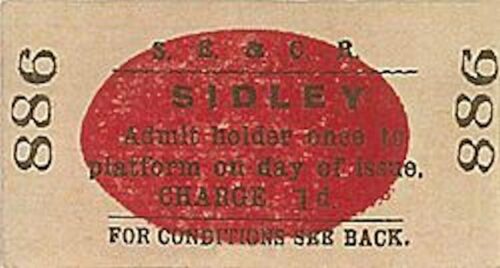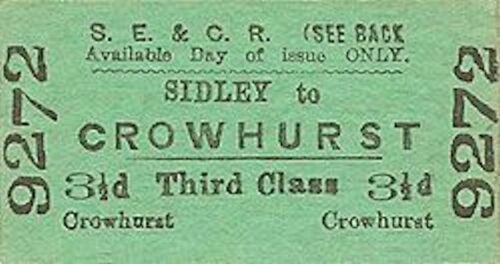All the following images and text has been taken from the on-line website “Disused Stations“, with the permission of Nick Catford, the site owner. The web address (URL) for the website is – http://www.disused-stations.org.uk/ – please note that the Internet and, therefore, this site cannot be accessed from this terminal.
Sidley Station was opened on 1st June 1902, just about two weeks after the Bexhill speed trial on the 19th May. It was built on the west side of Ninfield Road by the Crowhurst, Sidley & Bexhill Railway.
The Beeching ‘axe’ fell, on Sidley Station, in 1964, and British Railways (Southern Region), the then Company running the railways, closed it to passengers on 15th June.
Sidley station was sited in a deep cutting and was about 3 miles 25 chains from Crowhurst on a falling gradient of 1 in 260. Over 300,000 cubic yards of earth was excavated to accommodate the station and goods yard. The detached entrance building was of red brick and Bath stone, which, in the opinion of Gordon Biddle, a railway enthusiast and author created “a startling checkerboard effect beneath the eaves and on the gable” beneath the slate roof.
Sidley-001 – This view from the early years of the branch shows the unusual access to the platforms at Sidley from the street level building. Passengers left the building along a short corridor. From the building a flight of steps led down to a lattice footbridge with steps down to each platform. The street level building is viewed from the approach road to the goods yard.
Sidley-002 – More recent map showing position of Sidley Station – a small blue arrow indicates where it was located.
Sidley-003 – 1909 – This year’s 1:2,500 Ordnance Survey map shows the main station building on the west side of Ninfield Road opposite the Pelham Hotel. Access to the platforms was through the building or along a short path along the north side of the building. From the building a short flight of steps led down to the lattice footbridge that spanned the line. The two station buildings, which were of similar construction, faced each other and were set into a recess in the cutting. The stationmaster’s house is seen to the west of the street level building, overlooking the platforms.
Sidley-004 – 1930 1:2,500 OS map. Nothing has changed since the station opened. Access to the good yard was controlled by a signal box set into a recess in the cutting beyond the end of the up platform. One siding passed through large goods shed while another looped round it, running on to three long sidings to the south that were sometimes used for carriage stabling. To the north of the shed the siding terminated behind the up platform which could also act as a dock if necessary. The 1 ton 10 cwt yard crane is shown between these sidings opposite a loading dock. There was a reversal into another siding that served the coal yard.
At its opening the building contained a booking office, general waiting room, ladies’ waiting room and toilet, ticket and parcels office, gents’ toilet and stationmaster’s office. It was at street level next to the bridge and opposite the Pelham Hotel. Passengers would buy their tickets and leave the station building at the back of the booking office and then descend a few stairs to a lattice girder footbrReferidge, similar to that at Crowhurst, before tackling a flight of steps leading down to each platform. Following the temporary closure of the line in 1917, the footbridge and track were dismantled and transported to France for use by the war department. The first appointed stationmaster at Sidley was Mr Trigg who was transferred from Kemsing.
Both platforms were 490ft long and were originally graced by Arts and Crafts timber-framed pavilions with slate roofs. As was normal, the waiting rooms within them were provided with fireplaces. The down side platform building, which was slightly longer, also included a porters’ room and a store. In 1938 the Southern Railway decided to let the street level station building and transfer the booking office to the waiting room on the up platform. Near the Bexhill end of the down platform was the signal box which contained 20 levers while on the opposite side, trailing off the up line, were the goods yard and sidings. The 1904 “Railway Clearing House Handbook of Stations” lists Sidley as handling only general goods and parcels but there was a 1 ton 10 cwt capacity crane. By 1956 the yard handled a full range of goods, including livestock, but there was no mention of a crane.
A large brick shed which was built to a standard SECR design, was provided with one siding passing through it and another looping round it to the south. This siding split into three long sidings to the south-west parallel with the running lines. The yard crane was sited between these sidings opposite a small goods dock. These sidings were sometimes used for carriages and for a time after the First World War the SECR stored railmotors Nos. 2, 5, 6 & 7 there. To the north of the shed the siding ran behind the down platform which could also be used as a loading dock if required. The goods shed was larger than had originally been intended and was always under-utilised. By 1929 it was surplus to requirements and sold out of use by the Southern Railway. It was for many years used by Pepper & Son, Builders’ Merchant.
The street level building became a petrol station, surviving until 1971 when it was demolished to make way for the new petrol station which still stands on the site. The platforms and platform buildings were demolished in 1967 and, when visited in early 1968, only the ramps under the Ninfield Road Bridge survived. The cutting was infilled to about platform level and the levelled land used by a motorbike training centre which closed in 2012. The goods shed lasted much longer; in later years it was used by another builders’ merchant (M P Harris & Co) and, although standing empty and increasingly derelict for many years, it survived until early 2009 when it was demolished to make way for new industrial units. In post-war years Bowles Timber Yard and Hall & Co Ltd (coal merchants) also operated from the yard.


